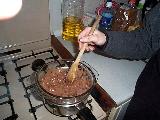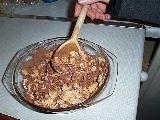Math Lab Activity
– Make 10 chocolate-covered cornflake cakes.
You will need:
- 10 Cake Cases,
- Some Chocolate,
- Some Cornflakes.
To work out how much chocolate and cornflakes you need see Ratio – Make Some Chocolate Crispies.
| Put the chocolate in a bowl over simmering water. Ask an adult to help you with this. Stir the chocolate until melted. |  |
 |
Take the melted chocolate from the heat. Add in the cornflakes and mix until the cornflakes are covered in chocolate. |
| Spoon the chocolate-covered cornflakes into cake cases and put them in the fridge for about one hour. They should be then ready to eat. |  |
Remember this is mathematics because you had to work out the amount of ingredients you had to use.
Remind the adults of this.
Practice
You can practice your ratio skills by Making Some Chocolate Crispies
To make these chocolate crispies I used:
- 20 g (grams) of chocolate
- 15 g of cornflakes or similar
Your mathematics task is to:
1) calculate the ratio of chocolate to cornflakes, and then:
2) work out the amount of ingredients to make 21 cakes.
1) We can see that the ratio of chocolate to cornflakes is 20:15
But this can be simplified further. The Greatest Common Factor is 5, so:
If we have 20 parts chocolate to 15 parts cornflake, divide each side by 5 and we get 4:3
This is the ratio of chocolate to cornflakes.
2) We need to work out how much chocolate and cornflakes we need to make 21 cakes.
The recipe is for 1 cake but we want 21, so multiply both ingredients by (21 cakes / 1 cake), or simply by 21:
- 21×20 = 420
- 21×15 = 315
So to make our 21 cakes we need:
- 420 g of chocolate
- 315 g of cornflakes
Ignite Your Mathematical Mind:
Let Your Logical Thinking Unleash to Explore the World of Wonders!
- If we only have 400g of chocolate, how many cakes can we make, and what quantity of cornflakes do we need?